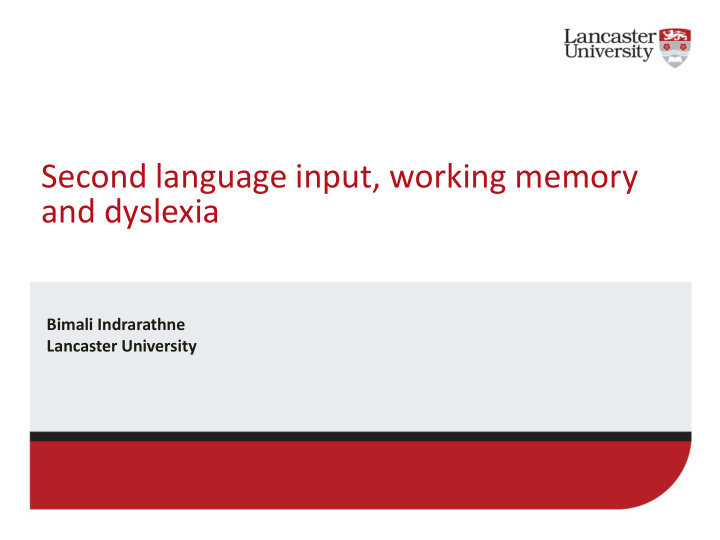



Second language input, working memory and dyslexia Bimali Indrarathne Lancaster University
Introduction My research Input processing Working memory Dyslexia and language learning Working memory Lower working memory capacity Helping learners Teacher training project for Sri Lanka Who? When?
My research • Attention is a necessary condition for learning (Leow, 2013; Robinson, Mackey, Gass & Schmidt, 2012) • Learners need to identify the language features in the input (Schmidt’s noticing hypothesis, 1995) • What type of input promotes attention? – Explicit? – Implicit? • Working memory and input processing – Directing learners’ attention to relevant features in the input (Ellis, 1996) – Processing input (Ellis & Sinclair, 1996)
My research W Explicit 1 O With an explanation of the target structure R K I N Explicit 2 P G P No explanation, but participants were asked to O R M pay attention to highlighted parts S E E M T T O Implicit 1 T R E Y No information, target structure highlighted E S S T T E T S Implicit 2 T No information, no highlighting S Control group
My research Participants – 100 undergraduates at a Sri Lankan university – Age between 18-22 – B1/B2 level of proficiency – 20 in a group Pre/post-tests – Sentence Reconstruction items – Grammaticality Judgement items – Free writing task Working memory tests Digit Span, Keep track, Plus minus, Stroop Target structure Causative passive
My research Eye tracking to measure attention – Tobii X2-60 portable eye tracker fixed to a laptop
My research
My research
My research
My research Significantly Explicit 1 higher amount of With an explanation of the target structure attention Explicit 2 Significant No explanation, but participants were asked to pay improvement in Higher WM: attention to highlighted parts the post-test better attention, better Implicit 1 Significantly lesser performance No information, target structure amount of highlighted attention Implicit 2 Very little or no No information, no highlighting improvement in the post-test Indrarathne & Kormos (2016), Indrarathne & Kormos (2017)
Dyslexia, working memory and language learning ELT Well
Dyslexia, working memory and language learning • Slow reading speed • Spelling issues • Mixing up words • Difficult to express themselves clearly • Poor concentration • Ineffective organizational skills • Low self-esteem • Short memory span (lower WM capacity) (International Dyslexia Association, 2012)
Dyslexia, working memory and language learning Significantly Explicit 1 higher amount of With an explanation of the target structure attention Explicit 2 Significant No explanation, but participants were asked improvement in Higher WM: to pay attention to highlighted parts the post-test better attention, better Implicit 1 Significantly lesser performance No information, target structure amount of highlighted attention Implicit 2 Very little or no No information, no highlighting improvement in the post-test
Working memory and language learning • reserved in group activities • rarely volunteering answers • avoid answering direct questions • behave as they have not paid attention • forgetting part or all of instructions • struggle in complicated tasks • poor academic progress • teachers find them easily distracted (Gathercole & Alloway, 2007)
Helping learners with lower working memory capacity • Input in parts • Shorter input sessions – more time for practice • Same input: different modes • Repeat • Recycle • Restructuring multi-step tasks to independent steps • Short instructions/ display them • Encourage learners to request information • Working memory training (http://www.cogmed.com/)
Teacher training project for Sri Lanka Partners Project website: http://www.dyslexiaprojectsl.com/
Teacher training project for Sri Lanka • Will educate ca. 100 English language teacher trainers in the country • How to identify learners with dyslexia and how to support them in the English language classroom • Training materials • Free resources and professional development opportunities available • Raise awareness among school principals, policy planners and language testing body of the country • May/June 2017
References Gathercole, S.E. & Alloway, T.P. (2007). Understanding working memory: A classroom guide. London: Harcourt Assessment.
References Ellis, N.C. (1996). Sequencing in SLA: phonological memory, chunking, and points of order. SSLA, 18 , 91-126. Ellis, N. C., & Sinclair, S. G. (1996). Working memory in the acquisition of vocabulary and syntax: putting language in good order. The Quarterly Journal of Experimental Psychology, 49A (1), 234-250. ELT Well. (2017). http://eltwell.com/ Indrarathne, B. & Kormos, J. (2016). Attentional processing of input in explicit and implicit learning conditions: an eye- tracking study. Studies in Second Language Acquisition. doi:10.1017/S027226311600019X. Indrarathne, B. & Kormos, J. (2017). The role of working memory in processing L2 input: insights from eye-tracking. Bilingualism: Language and Cognition . (in press) International Dyslexia Association .(2012). Dyslexia basics: fact sheet. Available at https://dyslexiaida.org/dyslexia- basics/ Leow, R. (2013). Attention, Noticing, and Awareness in Second Language Acquisition. In C. A. Chapelle (Ed.) The Encyclopedia of Applied Linguistics (pp. 1-7). Oxford, England: Blackwell Publishing Ltd. Robinson, P., Mackey, A., Gass, S. M., & Schmidt, R. (2012). Attention and awareness in second language acquisition. In S. M. Gass & A. Mackey (Eds.), The Routledge handbook of second language acquisition (pp.247-267). London, England: Routledge. Schmidt, R. (1995). Consciousness and foreign language learning: A tutorial on the role of attention and awareness in learning. In R. Schmidt (Ed.), Attention and awareness in foreign language learning (pp 1-63). Honalulu, HI: University of Hawaii, Second Language Teaching and Curriculum Centre.
Thank you
Recommend
More recommend